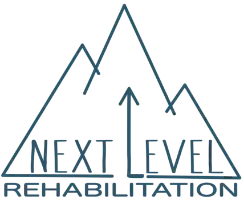PATIENT
INFORMATION
FREQUENTLY ASKED QUESTIONS
If you have any other additional questions, please email info@nextlevelrehab.org or call
(610) 389-4845
What can I expect during my session?
- All treatments are 1-hour, one-on-one, individualized sessions with Dr. Kimberly Malandra.
- Initial Evaluation - Includes a thorough review of medical/injury history and assessment of body systems, postures/positionings, joint/soft tissue, alignment, and functional movement patterns. Manual therapy, therapeutic exercise, neuromuscular re-education, etc. will be performed accordingly during the first session. Goals and expectations for treatment will be discussed.
- Follow-Up Visits - Include manual therapy techniques, therapeutic exercise, neuromuscular re-education, gait training, etc. according to your personalized treatment plan, as well as pertinent education to help you meet and exceed your goals. Continuous reassessment is carried out during these sessions, as necessary.
Do you take Insurance?
- No, Dr. Kimberly Malandra is a fee-for-service provider. This means that while Next Level Rehabilitation does not actively participate with insurance companies for visits, we can provide you with a super bill with proper diagnosis codes that can be submitted to your insurance company for partial or full reimbursement, depending on your plan. Call your insurance provider for details about out-of-network benefits for physical therapy. Next Level Rehabilitation is not a Medicare provider clinic and is unable to provide superbills for Medicare patients. For all patients, payments are due at the time of evaluation and treatment in the form of cash, check, credit/debit, or HSA.
What conditions do you commonly treat?
- As a holistic practitioner, I treat the body as a whole, working to find the root cause of your pain and dysfunction. However, the traditional medical model will continue to label pain and impairments locally, therefore some examples of treatable conditions are as follows:
- Musculoskeletal/ Neurologic
- Acute or Chronic Pain
- Arthritis/ Spondylosis
- Spine Pain (Cervical, Thoracic, Lumbar, Sacroiliac)
- Radiculopathy (Cervical, Thoracic, Lumbar)/ Sciatica
- Herniated Disc
- Degenerative Disc Disease, Degenerative Joint Disease
- Balance & Fall Prevention
- Overuse Injury/Tendonitis/Tendinopathy/Tendinosis
- Muscle Strain or Tear/Repair
- Ligament Sprain or Tear/Repair
- Shoulder Impingement
- Pain (Shoulder, Elbow, Wrist)
- Pain (Hip, Groin, Knee, Ankle, Foot)
- Sports Injuries/ Golf Fitness
- Joint Replacements & Post-Surgical
- Visceral
- GERD/Acid Reflux
- Bloating/ Constipation
- Nervous System (Sympathetic & Parasympathetic)
- Anxiety, Stress, Depression
- Post-Surgical scar
How Does Visceral Manipulation Help?
- Visceral Manipulation is used to locate and resolve problems throughout the body. It encourages the body’s own natural mechanisms to improve the functioning of organs, dissipate the negative effects of stress, enhance mobility of the musculoskeletal system through connective tissue attachments, and influence general metabolism. If various tissues are restricted or organs are unable to move properly because of an injury, illness, accident, etc., then they do not function optimally.
- For instance, the force of a seatbelt during a collision can cause restrictions of the tissues around a patient’s liver. In this case, the liver is not able to move normally, and the function of the liver can decrease. Also, the liver attachments—diaphragm, rib cage, spine, stomach, kidneys, etc.—are adversely affected. The patient might begin to feel pain and stiffness in their neck, right shoulder, ribcage, and spine, as well as experience low energy and poor digestion. By addressing the tissue restrictions around the liver with VM, which is the source of the cascade of symptoms, the person will begin to function optimally again.
How do Organs Contribute to Pain and Dysfunction?
- Our body is made up of many interrelated components such as bones, muscles, nerves, and fascia, as well as the internal organs (viscera). Your organs are in perpetual motion. When you breathe, walk, and stretch, your organs move in your chest and abdomen. For example, when you take a breath, your kidneys move one inch; and with deep inhalation, they move 4 inches. In a day, they move a little over 1/2 mile. That’s around 19,000 miles a lifetime!
- Imagine scar tissue around the lungs. Because of the pull of the adhesion, with every breath, the movement patterns of the nearby structures would be altered. This could shift rib motion creating pulls on the spine. These restrictions might then show up as mid-back and neck pain, as well as limited motion in the shoulder. This scenario highlights just one of the hundreds of possible ramifications of a small dysfunction —magnified by thousands of repetitions each day. This also explains how pain can often be far removed from the actual cause.
DOWNLOADS
PRINTABLE FORMS
To maximize time, you can print and fill out these forms prior to your first visit. If you have any difficulty, the forms are also available in person.
